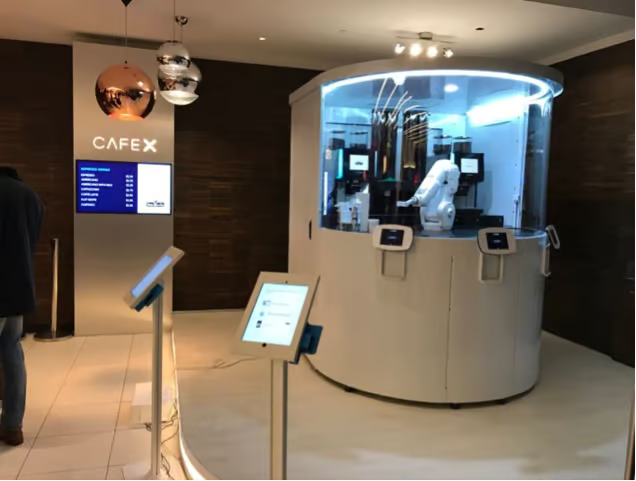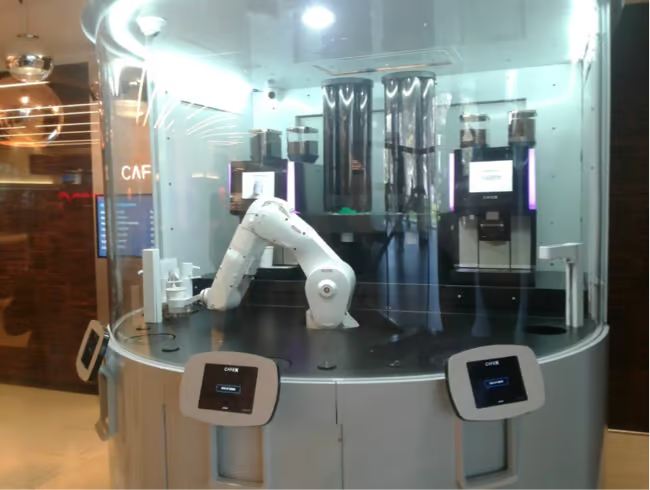Meet Gordon, your eye-catching new barista. He’s polished, intelligent, distinguished, and here’s his greatest feature: he can make 100-200 cups of coffee an hour. His least appealing qualities you ask? He’s severely lacking interpersonal skills and has zero game. Also, there is just ONE more thing to mention about him…he’s a robotic arm. In fact, Gordon is programmed to make the perfect cup of coffee using beans from local favorites like Peets, Verve Coffee Roasters, and AKA coffee. All of you lucky singles, cafe hipsters and dark roast gurus can meet this hunk of metal at Cafe X, which opened its figurative doors earlier this year in San Francisco in hopes of providing a more efficient experience for coffee aficionados. Though more like a fully enclosed kiosk than a traditional coffee shop, Cafe X still shares the same common goal as their competitors: provide customers with a cup of coffee consistently and conveniently.
 The setup is simple. Customers can order their drink in advance from the Cafe X mobile app, or at one of two iPads mounted outside on site. After the cashless order is placed, Gordon begins showing off by simultaneously operating a pair of standard professional coffee machines while serving premium drinks (1-4 per minute to be exact). Once the beverage is ready, customers use the iPads to type in a four-digit order number, which was sent to them via text message or displayed on the Cafe X mobile app for iOS or Android. The Mitsubishi-built, robotic arm identifies the customer’s drink from the waiting station and then delivers their fragrant, piping hot latte within seconds. Thanks to Gordon’s artificial-intelligence software, pre-orders are taken into consideration alongside walk-in orders to ensure no one is waiting too long.
The setup is simple. Customers can order their drink in advance from the Cafe X mobile app, or at one of two iPads mounted outside on site. After the cashless order is placed, Gordon begins showing off by simultaneously operating a pair of standard professional coffee machines while serving premium drinks (1-4 per minute to be exact). Once the beverage is ready, customers use the iPads to type in a four-digit order number, which was sent to them via text message or displayed on the Cafe X mobile app for iOS or Android. The Mitsubishi-built, robotic arm identifies the customer’s drink from the waiting station and then delivers their fragrant, piping hot latte within seconds. Thanks to Gordon’s artificial-intelligence software, pre-orders are taken into consideration alongside walk-in orders to ensure no one is waiting too long.
 Cafe X isn’t completely human-less. Gordon needs a technician sidekick to clean and restock the coffee machines, and there’s always a product specialist on-site to assist in offering suggestions to customers. Additionally, Gordon will always be reliant on his software and hardware engineers to manage the app and kiosk, just in case the caffeine rush becomes too cumbersome. Although there’s less human interface than there is at your typical coffee shop, Cafe X continues to draw fast-moving lines and curious customers who snap photos and videos of their unique experience.
Cafe X isn’t completely human-less. Gordon needs a technician sidekick to clean and restock the coffee machines, and there’s always a product specialist on-site to assist in offering suggestions to customers. Additionally, Gordon will always be reliant on his software and hardware engineers to manage the app and kiosk, just in case the caffeine rush becomes too cumbersome. Although there’s less human interface than there is at your typical coffee shop, Cafe X continues to draw fast-moving lines and curious customers who snap photos and videos of their unique experience.
Now that we’ve gotten our coffee fix, it’s time to move onto the good stuff, FOOD! Automation certainly isn’t a new phenomenon in the restaurant industry, yet it is constantly being redefined. Consider Eatsa, a fast-food chain that has integrated automation into its operations by swapping its servers, cashiers, and busboys for computer kiosks, LED-lit cubbies, and bright screens. It was founded in San Francisco in 2015, but has since expanded its markets to Manhattan and Washington, D.C.
 Each store only requires three cooks (not robots…yet) who, behind closed doors assemble made-to-order vegetarian, quinoa-centric bowls. In the dining area, one or two tablet-clutching ‘red shirts’ (picture Apple Geniuses) float among customers to answer questions about the ordering process. After swiping some plastic at one of the tablets (futuristically, cash isn’t accepted), customers are presented with an extensive, highly-customizable menu. If you prefer to order ahead of time, customers can download the Eatsa mobile app to customize their bowl and schedule a time for pickup. After an order is placed, customers migrate over to a giant, eye-catching LCD screen that displays the names of those waiting for their food. When your food is ready, a number flashes next to your name prompting you to visit a cubbie with that same corresponding number. Simultaneously, the transparent LCD-screen cubbie, will then light up with customer’s name, enticing them to claim their meal (and likely snapchat as they do so). By simply double tapping the glass, the window slides up and reveals your food in all its glory.
Each store only requires three cooks (not robots…yet) who, behind closed doors assemble made-to-order vegetarian, quinoa-centric bowls. In the dining area, one or two tablet-clutching ‘red shirts’ (picture Apple Geniuses) float among customers to answer questions about the ordering process. After swiping some plastic at one of the tablets (futuristically, cash isn’t accepted), customers are presented with an extensive, highly-customizable menu. If you prefer to order ahead of time, customers can download the Eatsa mobile app to customize their bowl and schedule a time for pickup. After an order is placed, customers migrate over to a giant, eye-catching LCD screen that displays the names of those waiting for their food. When your food is ready, a number flashes next to your name prompting you to visit a cubbie with that same corresponding number. Simultaneously, the transparent LCD-screen cubbie, will then light up with customer’s name, enticing them to claim their meal (and likely snapchat as they do so). By simply double tapping the glass, the window slides up and reveals your food in all its glory.
Wait…the Jetson’s totally called this.
Although automation hasn’t completely upended the food service sector yet, it’s apparent that its landscape has begun to shift. Cafe X and Eatsa are just two example of companies who have redefined the industry, but given the politics of wage and the cost-effectiveness of machines, it wouldn’t be surprising to see more and more business proprietors start adopting automated advancements. Another alluring aspect of automated technology is that, if integrated properly, can enhance customer experience. For companies seeking to tap into this generation of consumers, it’s critical to identify opportunities where millennial-friendly technology can seamlessly coincide into their dining experience. Millennials want food that is less-time intensive; patience has gone down, convenience is key, and having control is strongly desired. And what better way to appeal to these needs by using something that’s already second nature to them – technology.
The questions is, at what point do the convenience desires of a younger generation supersede the labor force’s need for minimum wage jobs? Be it kiosks, ordering via smartphone, or something else, it’s clear that technology can eliminate the need for interacting with humans when placing an order. Sure, automation is bound to make some jobs obsolete in the coming years, but it’s unlikely that this transformation will happen overnight. Nevertheless, the future of automation has become an ever-increasing topic of discussion lately. Some view it as the greatest threat to the American economy, while other see it as an opportunity to jumpstart it. Regardless of your stance, the move toward automation and artificial intelligence is poised to accelerate.
I bet if we were farmers sitting in a room two decades ago, we’d rightfully be worried about our future employment. But as time progressed, new jobs and industries that we would have never fathomed were created. No one would have predicted twenty-five years ago that there’d be a need for app developers, social media producers, or brand strategists, but industries and roles have evolved over time – just how they’ll continue to do so in the future. From my POV, if you want to stay relevant and flourish in the coming years, be curious, adaptable, open-minded, and always eager to acquire new skills.

